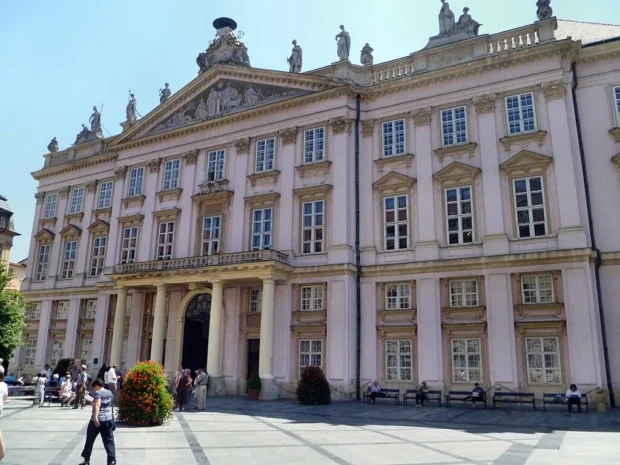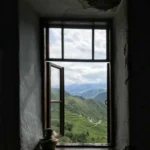Bratislava, with its charming old town and beautiful setting on the Danube River, invites visitors to slow down and enjoy simple pleasures. This city, lively yet gentle, is a blend of rich history, friendly faces, and surprising details that stay with you long after leaving. Whether you arrive by train, plane, or bus, getting to and around Bratislava is easy. In this travel story, we’ll take you past the well-known landmarks, through quiet courtyards, and into lively markets. Along the way, we’ll share tasty bites, useful local words, and customs that help you feel at home here.
Table of Contents

Walking Among Bratislava’s Famous Landmarks
Start your Bratislava visit at the Old Town, where narrow cobbled streets lead you past colorful buildings and inviting cafes. One of the city’s most beloved sights is Bratislava Castle, sitting proudly on a hill overlooking the Danube. From here, you can watch boats drift by and see the borders where Slovakia meets Austria and Hungary. The castle itself has stood since the 9th century, rebuilt many times, and now houses historical exhibitions. It is not just a photo stop; the views and atmosphere make it a peaceful place to pause.
To deepen your understanding of Bratislava’s history, the detailed story of Bratislava Castle offers fascinating insights into its royal past and scenic surroundings.

Nearby, the SNP Bridge (Slovak National Uprising Bridge) stands out with its UFO-shaped lookout tower. Locals call it “Most SNP” and enjoy panoramic city views from its restaurant. It feels like a little trip into the future, contrasting with the Old Town’s medieval charm.
If you enjoy riverside cities, the peaceful charm of Ljubljana’s streets and bridges offers a lovely next step.
For travelers inspired by Bratislava’s riverside charm, the vibrant city of Madrid’s must-see places offers a lively contrast with its historic squares and rich café culture.

Strolling down to the riverside promenade, you can see the blue Danube sparkles under the sun. Here, the small but fascinating Slovak National Theatre building adds grace to the scene. Across the river, the modern Eurovea shopping center mixes green spaces with shops and cafes-a reminder of Bratislava’s vibrant everyday life.

Hidden Corners and Quirky Finds
Beyond the main attractions, Bratislava reveals secrets for the curious traveler. A short walk from the Old Town, you’ll find the quirky Cumil statue-a bronze man peeking from a manhole cover. Locals say he’s a friendly “watcher” of the city’s daily life. Don’t miss the charming courtyard at St. Martin’s Cathedral, where locals often sit and chat under the trees.

If you want to feel like a local, head to the Miletičova neighborhood. Here, you can walk through peaceful streets lined with quirky cafes, small galleries, and bakeries filled with irresistible pastries. The open-air market at Miletičova is a perfect stop for fresh fruits, traditional cheeses, and friendly conversations with vendors.

Flavors of Bratislava: What to Taste and Where
Slovak food is comforting and hearty, perfect for the sometimes chilly Danube winds. Try bryndzové halušky, small potato dumplings with sheep cheese and crispy bacon bits, a national favorite. You’ll often find it in cozy family-run eateries in the Old Town or around the Petržalka district. For a sweet treat, taste trdelník-a rolled pastry grilled on a spit and sprinkled with sugar and walnuts. Though popular in tourist areas, the best are made fresh in local bakeries away from the busiest streets.

When you want a light meal, stop by a local “koliba,” a traditional Slovak wooden house restaurant. They serve soups like kapustnica, a warm cabbage soup with sausage, perfect after a day’s walk. Don’t forget to enjoy a cup of strong Slovak coffee at a café-here, the word “káva” is your key to a good break.

How to Get Around Bratislava Without Fuss
Bratislava’s public transport is simple and reliable. From the airport, frequent buses connect to the center, making your first step easy and affordable. Buses and trams run regularly across the city; a short trip is just a couple of euros. Tickets need to be bought before boarding, usually from machines or nearby booths, and validated right after you get on.

Walking is one of the best ways to feel the city’s rhythm. The Old Town’s compact size means many sights are just minutes apart. Renting a bike or using electric scooters, which you find everywhere, is also a popular way to explore sunny days along the Danube paths.

Understanding Bratislava’s Customs and Local Life
Slovaks are polite and reserved but warm once you start a friendly chat. Greeting with a simple “Dobrý deň” (Good day) shows respect. After a meal, saying “Ďakujem” (Thank you) is appreciated. When invited to someone’s home, bringing a small gift like flowers or sweets is a nice gesture. It’s best not to speak loudly in public or rush people; Slovaks value calm and patience.
A small funny note: many locals love to joke about the weather and Slovakia’s many castles, often saying “Na každé kopci je zámok” (On every hill there is a castle), which shows both pride and humor about their landscape. The phrase “Ako sa máš?” means “How are you?” and is a friendly way to start conversations. If you want to say “Goodbye,” you can say “Dovidenia.”
Where to Stay for a True Bratislava Feeling
Choosing where to stay depends on what you want. The Old Town is lively and filled with historic flair, perfect if you want to be close to cafes and nightlife. For a quieter rest, districts like Petržalka offer green parks and river views, with easy transport links to the center. If you enjoy local neighborhood vibes, the area around Staré Mesto has charming guesthouses and apartments blending old beauty with modern comfort.
Accommodation here feels personal, often hosted by locals happy to share stories of Bratislava’s past and present. This adds warmth to your stay, making the city feel more like a friend than just a place to visit.
Stories and Myths from Bratislava’s Past
Bratislava’s history is a patchwork of cultures, empires, and myths. It was once the coronation city for Hungarian kings, which left behind beautiful buildings and legends. One popular myth tells of the “White Lady” ghost who supposedly roams Bratislava Castle at night, a mysterious figure adding a touch of magic to your visit under moonlight.
The city’s location on the Danube has made it a meeting point of traders, artists, and builders for centuries. Walking its streets, you might spot old signs in German or Hungarian, reminding you that this quiet city has been a lively crossroads. Even the fountain in the Main Square, with its playful statue of Roland-a knight who defended the city-tells a story of bravery and community pride.
Final Thoughts on Bratislava’s Slow Rhythm
Bratislava invites you to move at its own pace. It’s not about rushing from one point to another but about enjoying details-the scent of fresh bread in a market, the sound of folk music drifting from a hidden café, or the quiet moment watching the Danube’s riverboats glide past. This city may be small, but its spirit is large and welcoming. A place where history lives side by side with modern life, and every corner offers a new reason to smile and stay a little longer.

Eastern Europe travel specialist uncovering hidden gems from the Baltics to the Balkans.
- Bratislava Panorama R01 by Marc Ryckaert (MJJR) on Wikimedia Commons – cc by 3.0
- Bratislava Castle, 20210727 1057 0312 by Jakub Hałun on Wikimedia Commons – cc by-sa 4.0
- Bratislava-Old Town, Slovakia – panoramio (145) by Андрей Бобровский on Wikimedia Commons – cc by 3.0
- Bratislava – St. Martins Cathedral 02 by J_Makk on Wikimedia Commons – cc by-sa 2.0
- Slavin memorial, Bratislava by John Menard from Phoenix, USA on Wikimedia Commons – cc by-sa 2.0
- Donauradweg near Most SNP in Bratislava by JIP on Wikimedia Commons – cc by-sa 4.0
- Bratislava – Michalská brána (1) by Fred Romero from Paris, France on Wikimedia Commons – cc by 2.0
- Bratislava 071 by JoJan on Wikimedia Commons – cc by 3.0
- Blue Church, Bratislava 01 by Thomas Ledl on Wikimedia Commons – cc by-sa 4.0
- Devín Castle, 20220428 1023 5746 by Jakub Hałun on Wikimedia Commons – cc by-sa 4.0
- Bratislava – Hviezdoslavovo námestie – View ENE II by Txllxt TxllxT on Wikimedia Commons – cc by-sa 4.0
